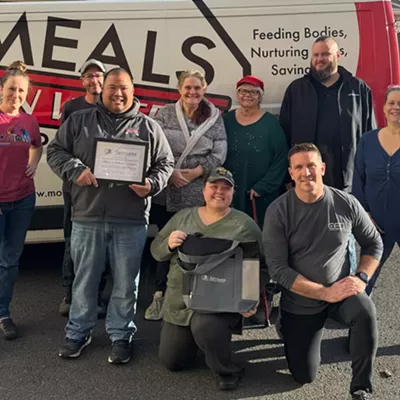It’s been more than a decade since Gerry Cook, an inventor in Sandpoint, Idaho, started work on his bicycle pedaling system. But in true inventor fashion, he never finished it. He got sidetracked.
Those distractions, inspired by requests from a physical therapist, have produced far greater success than he possibly could have imagined. He’s turned an experimental therapy device for a Seattle SuperSonics basketball player into multiple unique physical therapy machines now used in 30 clinics across the nation.
Some evidence, he says, indicates his technology could be a major development for those suffering from back pain.
At the Revita Clinic in Spokane Valley, David Robinson is confident about the impact of the clinic’s therapy.
The 62-year-old man has had arthritis — his spine was deteriorating, and he was having lower back problems. It wasn’t agonizing pain, but it was perpetual discomfort. He felt “brittle,” he says.
But his investment manager suggested he stop by the Revita Clinic. Now, toward the end of two-and-a-half months of therapy, he’s pleased. Each session leaves him feeling better longer than a session with a chiropractor, he says.
“It’s been more successful than the ordinary massages,” Robinson says. “This has more of a long-term effect than a lot of the other programs I’ve tried.”
At Revita, it’s a multi-step process across at least six different machines. Every machine but one was designed by Gerry Cook at Pneumex.
A few of the machines use “unweighting,” harnesses that slightly lift the subject. Cook says it gives many of the advantages of relearning to walk in water, without water’s inherent resistance. Injuries can force unnatural or dangerous movement — like walking with a limp or trudging with a back injury. That can spawn other injuries and other problems. Machines using unweighting can help solve that.
A harness above a treadmill, for example, allows injured patients to walk or run using correct form and posture without pain. A baseball player, Cook says, who favors one side over the other can use an unweighted treadmill to be taught to strengthen his weak side. He says Sandpoint High School installed four of his unweighted treadmills in the weight room.
Other machines use whole-body vibration to relax and stimulate muscles.
“I was the biggest skeptic going in,” Cook says about vibration, “I thought it was crazy. Now I’m probably the biggest proponent.”
The premise, he says, is simple. If he pushed you, you’d respond — you may push back, and you’d automatically work to keep your balance. Vibration at 600 to 3600 times per minute, he says, not only works to strengthen the muscles, it can also relax them and increase blood flow — and relieve pain.
“That’s one of the biggest impediments to rehab, people are afraid to move because of the pain,” Cook says.
Steve Neff, co-owner of Pneumax, walks InHealthNW through the process that patients like Robinson undergo.
1) It starts at the Pneu-Map, a Pneumex device that rolls over the curvature of a spine, comparing it on a grid to a healthy spine.
2) The patient lays on the VibroTrac, a table that combines unweighting and vibration. Connected to a four-way harness, the harness alternately stretches the patient — think of how a car accident victim might be suspended in traction — and relaxes as the patient performs exercises.
3) The patient walks on a treadmill while suspended by an unweighting harness.
4) With the help of the physical therapist, the patient performs exercises while sitting in a Pneuback unweighting chair.
5) The patient stretches his body on a wholebody vibration chair — one of the few machines not manufactured by Pnuemex.
6) Finally, the patient performs more exercises standing on a vibrating platform and leaning against a resistance belt.
But the next step, for both Revita and Pnuemex, is determining how effective it really is.
“We can rehydrate [spinal] discs,” Cook claims. “We’ve seen it on a lot of pre-and post MRIs.”
Washington State University in Spokane has already undertaken an initial “proof of practice” study that determined Revita resulted in “marked improvements in pain, posture, and … quality of life in adults with chronic back pain.”
Emily Carolyn Johnson, an associate professor in the department of nutrition and exercise physiology at Washington State University, worked with an undergraduate research student to compare questionnaires from Revita patients before 12 weeks of therapy and after 12 weeks of therapy.
“Not being an orthopedic researcher, I was a bit surprised with the magnitude of the effect,” Johnson says. “They reported quite a bit of improvements.”
She stresses, however, that without a control group, some of the improvement the survey found could have come from the placebo effect.
Research has been mixed for people with neurological impairments: While one study found that whole body vibration training machines can be effective for helping stroke or cerebral palsy victims to regain strength, another study showed it was ineffective for multiple sclerosis patients.
Now the Pnuemex machines have become part of a 36-person study that compares the Revita method to conventional physical therapy. But Neff says the study is struggling to find enough of the right sort of patients to complete it. Instead, the clinic might begin to simply compare its own data to data from other physical therapy clinics.
Either way, Neff sees his clinic as the next step in helping to solve back pain.
“This isn’t revolutionary,” Neff, says. “It’s more evolutionary. It’s another tool in our toolbox. And we need new tools.”




















